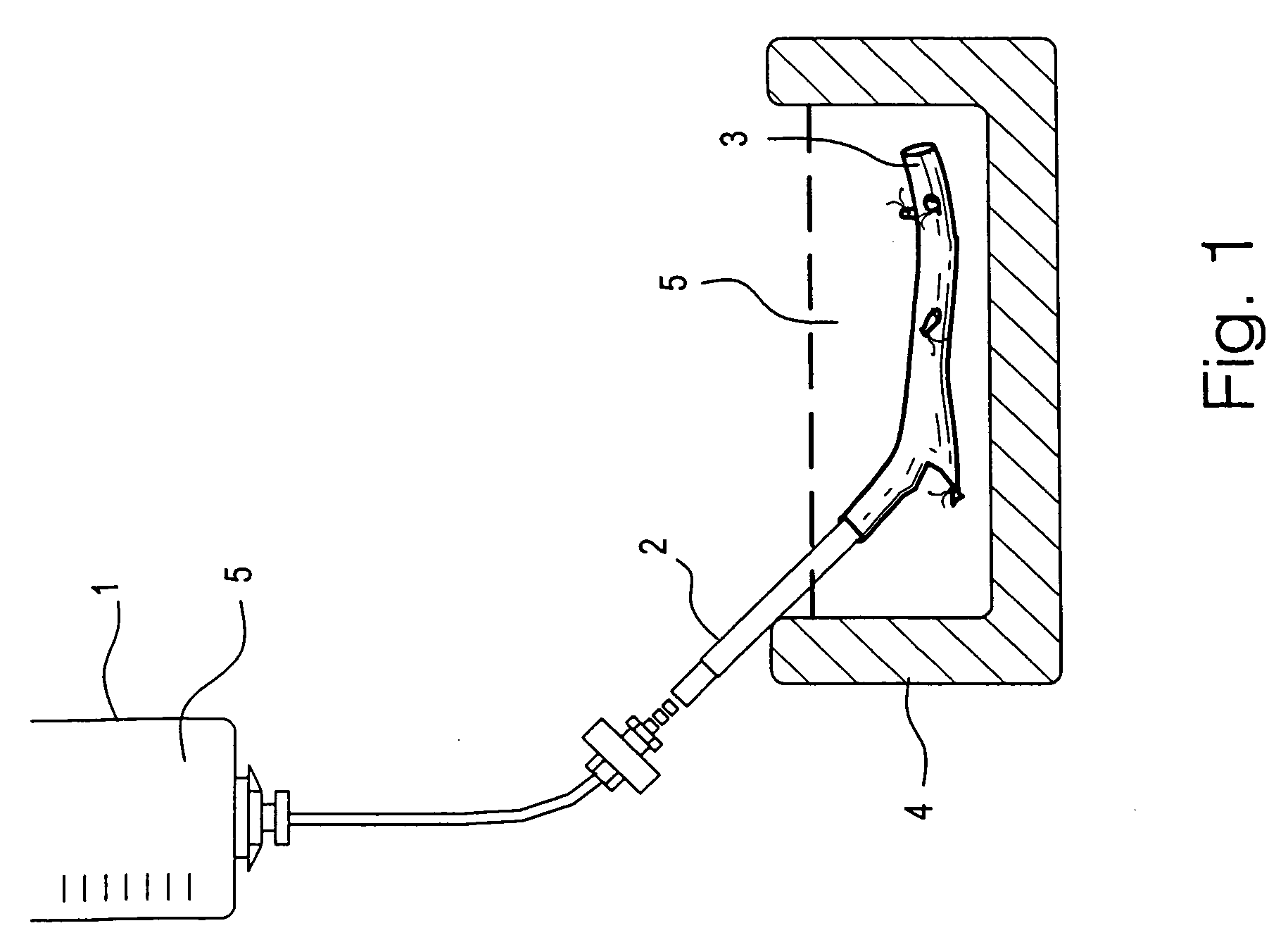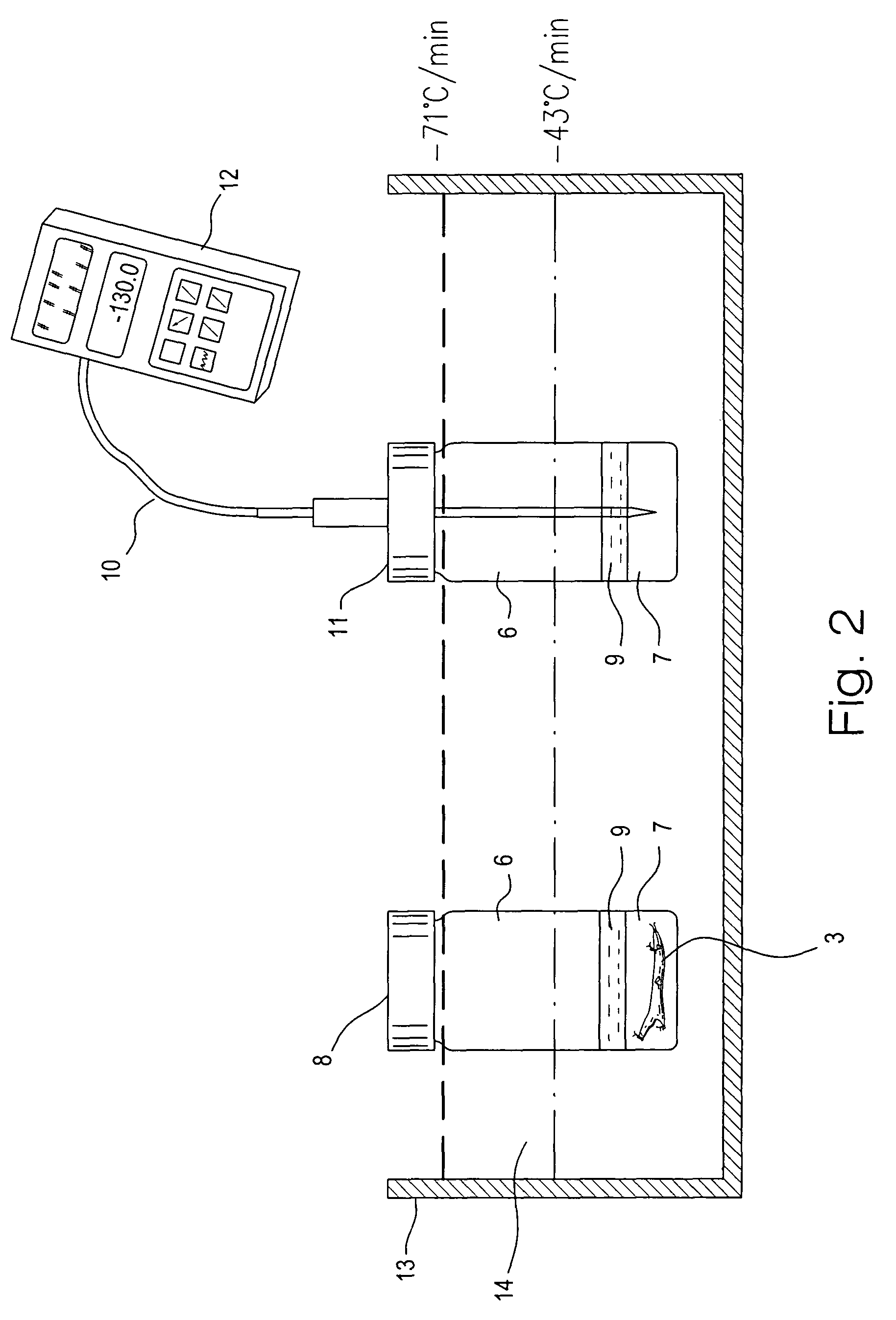Method of cryopreservation of tissues by vitrification
a tissue and cryopreservation technology, applied in the field of cryopreservation of tissues by vitrification, can solve the problems of limited study, inability to obtain viable tissues and cells, and many patients without suitable autologous veins, and achieve direct protective effects on the cell membrane and rapid rate
- Summary
- Abstract
- Description
- Claims
- Application Information
AI Technical Summary
Benefits of technology
Problems solved by technology
Method used
Image
Examples
example 1
Blood Vessels
[0073]The external jugular vein was obtained from New Zealand white rabbits. The distal site of each vein segment above the bifurcation was cannulated in situ with a silicone tube. The proximal site was left open for fluid outflow. The vein segments, which were about 40–60 mm long, were perfused at 0° C. to 4° C.
[0074]To perfuse the veins, the perfusion system of FIG. 1 was used. The perfusion system comprises a reservoir 1 (a 60 cc syringe) containing perfusion solution 5 connected to the cannula 2 with a 3-way stopcock. The reservoir 1 was adjusted to physiologic pressure. The vein 3 was placed in a petri dish 4 (Dia.×H, 50×15 mm) containing perfusion solution 5. The perfusion solution 5 in both reservoir 1 and petri dish 4 was the same and was pre-cooled (0° C.–4° C.) and the petri dish 4 was placed in ice (0° C.–4° C.) during the perfusion process.
[0075]The vitrification solution used was VS55. The full strength VS55 solution was introduced in six serial steps. In t...
example 2
[0095]Pig cartilage was used in this study. The sample size was varied from 100–300 mg, and >300 mg. The experiments included fresh control and vitrification groups. The tissue viability was tested using Alamar Blue assay.
[0096]Outbred pigs of either sex, weighing 30–60 kg, were selected in this pilot study. The animal was weighed and then anesthesia was induced with 33 mg / kg ketamine and 1.1 mg / kg acepromazine, and isoflurane was delivered in oxygen via a face mask. After intubation, anesthesia was maintained using isoflurane delivered in oxygen. Pig knee cartilage was harvested for subsequent studies.
[0097]Prior to subzero cooling, the cartilage tissue samples were exposed to the cryoprotectant mixture by adding the vitrification solution VS55 in six steps, for 15 minutes each, on ice (4° C.). This was accomplished in a glass scintillation vial (Dia.×H, 25 mm×60 mm) containing Euro-Collins solution, with successive steps increasing the concentration of cryoprotectant in t...
example 3
Additional Tissues
[0101]Pigs were selected as an animal model for a source of various tissues for testing the feasibility of vitrification for long-term storage of tissues. The sample size was varied from <100 mg and 100–300 mg. These pilot experiments included fresh control and vitrification groups. The tissue viability was tested using the Alamar Blue assay.
[0102]Outbred pigs of either sex, weighing 30–60 kg, were selected in this experiment. The animal was weighed and then anesthesia was induced with 33 mg / kg ketamine and 1.1 mg / kg acepromazine, and isoflurane was delivered in oxygen via a face mask. After intubation, anesthesia was maintained using isoflurane delivered in oxygen. Pig heart valves, myocardium, skin and corneas were harvested for subsequent studies.
[0103]Prior to subzero cooling, the tissue samples were exposed to the cryoprotectant mixture by adding the vitrification solution VS55 in six steps, for 15 minutes each, on ice (4° C.). This was accomplished in a glass...
PUM
 Login to View More
Login to View More Abstract
Description
Claims
Application Information
 Login to View More
Login to View More - R&D
- Intellectual Property
- Life Sciences
- Materials
- Tech Scout
- Unparalleled Data Quality
- Higher Quality Content
- 60% Fewer Hallucinations
Browse by: Latest US Patents, China's latest patents, Technical Efficacy Thesaurus, Application Domain, Technology Topic, Popular Technical Reports.
© 2025 PatSnap. All rights reserved.Legal|Privacy policy|Modern Slavery Act Transparency Statement|Sitemap|About US| Contact US: help@patsnap.com



